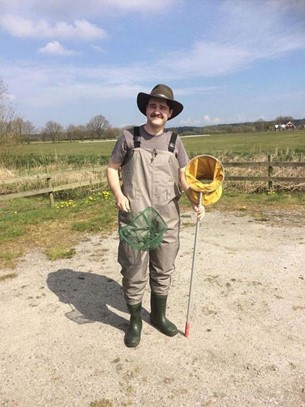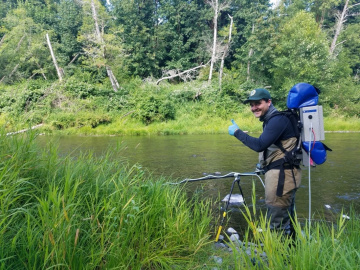Philip Ericssons RIBES story
Hello! My name is Philip Ericsson, and I am a Swedish-American hailing from the San Francisco Bay Area in California. I’ve had an interest in ecology for as long as I can remember. As a kid, I spent my time watching too much of The Crocodile Hunter on tv, chasing lizards, flipping logs to find bugs, and visiting aquariums. This fascination with the natural world led me to get certified as a SCUBA diver in high school and once I was underwater I knew that I didn’t want to surface again. My interest in underwater environments naturally guided me into my undergraduate career at the University of California, Santa Cruz, where I studied marine biology. During this time, I began volunteering as a research diver, and over the following three years I contributed to several projects that monitored the health of marine protected areas along the pacific coast of North America.
 Philip gearing up to collect macroinvertebrates from a stream in Skåne county, Sweden.
Philip gearing up to collect macroinvertebrates from a stream in Skåne county, Sweden.
In 2015 I made the decision to pursue a master’s degree, and in 2016 I was accepted into the aquatic ecology program at Lund University. While studying there, I became fascinated with the ecological drivers and consequences of intraspecific behavioral and physiological variations between individuals. Through learning about the department’s research on inducible defenses in Crucian Carp, and my own thesis work which examined how competitive outcomes and metabolic rates in the invasive Round Goby depend on an individual’s personality, I was introduced to the concept that these kinds of behavioural differences do not merely represent “noise” around a mean response, but rather that they can indicate consistent responses that relate to an individual’s fitness and life history strategy.
I continued thinking about these differences after I graduated and began working as a Project assistant for the River Ecology and Management Research Group at Karlstad University, and later as a Scientific Technician with the Washington State Department of Fish and Wildlife. During this time, I worked on projects designed to improve downstream passage solutions for the critically endangered European eel, understand the effect that dams have on stream communities and how streams respond to dam removal, and to monitor the status of fall spawning salmonids in south western Washington State. Through working long hours in the lab and out in the field, I began connecting the threads of my research experience, and I came to recognize the need to incorporate intraspecific variation into issues of river conservation and fisheries management.
 Philip taking an eDNA sample from the Chehalis River in Washington State, USA.
Philip taking an eDNA sample from the Chehalis River in Washington State, USA.
I recognized the MSCA-RIBES PhD positions as my opportunity to pursue these research topics and to advance my career in a meaningful way. I am now working towards my PhD at the University of Southampton. My project, titled “Quantification of Fish Response to Multimodal Signals” employs a reductionist approach to study how fish behaviour and physiology respond to varying acoustic and hydrodynamic conditions, taking full advantage of the university’s range of experimental tanks and flumes. This work takes place as part of the University of Southampton’s Centre for Doctoral Training cohort “Sustainable Infrastructure for Cities” (CDT-SIC) and I am supervised by Professor’s Paul Kemp and Paul White from the International Centre for Ecohydraulics Research (ICER) in the Faculty of Engineering and Physical Sciences. The collaborative and interdisciplinary approaches emphasized by both ICER and the CDT-SIC are exciting to me, and I am looking forward for the opportunity to connect my research to answer applied problems such as the development of improved fish passage and deterrent systems.
Looking forward to the rest of 2021, I am excited to begin experimentation for my project in earnest. Anthropogenic activities in waterways modify the hydrodynamic and acoustic environments in which fish, and other aquatic organisms, must persist and I am eager to begin teasing apart the complex ways in which these signals can combine to impact fish behaviour and physiology. Identifying emergent effects of multi-modal signals will not only help us understand how fish perceive and process information from the environment but will also help to develop new mitigation technologies to reduce the impact of anthropogenic habitat disruption, and information learned from these studies may also be used to develop improved physical and behavioural fish guidance solutions.
